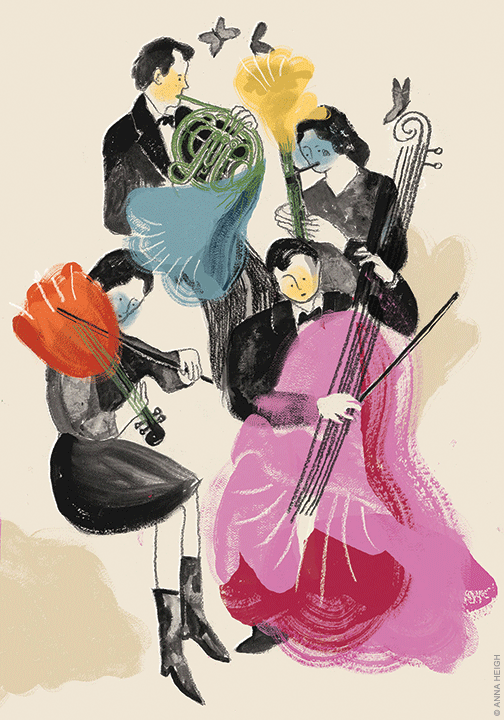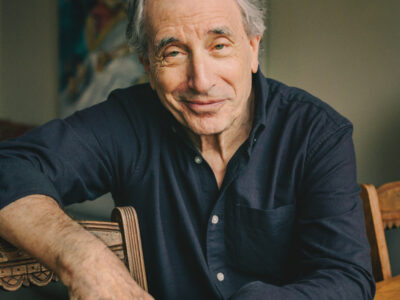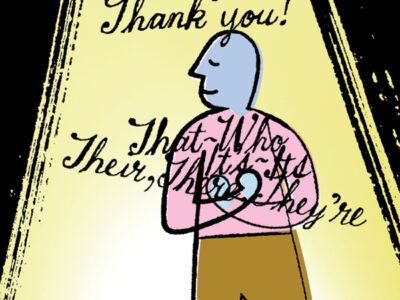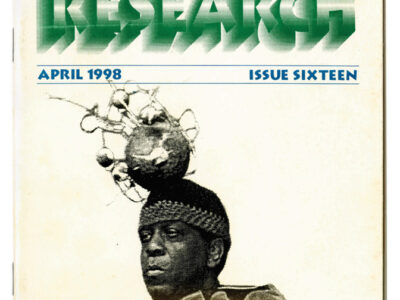
The idea of forming a chamber orchestra first came to Marc Mostovoy G’67 in 1963. He was 21, having just graduated from Temple University with a degree in musical education, and was spending the second of three summers in France studying musicianship with Marcel Tabuteau, who had retired as principal oboist of the Philadelphia Orchestra in 1954.
“I suggested that he come back to the States to record some oboe concertos—his earlier recordings did not do him justice because microphones then were not sensitive enough to pick up the subtleties of his playing,” recalls Mostovoy, who had also studied conducting with Wilfred Pelletier and Hans Swarowsky. “Tabuteau liked to conduct as well, and I thought how wonderful it would be to provide him with a fine chamber orchestra that he could record with and lead. Meanwhile, the orchestra and I would have the opportunity to work with a truly inspiring musician.”
Tabuteau responded enthusiastically, and though he died before he could return to the States, Mostovoy, who played viola, had already formed the core of the ensemble in 1964. By then he was a graduate student in Penn’s music department, and he persuaded a number of Penn students, along with musicians from the Curtis Institute and other area music schools, to join the ensemble.
This season marks the 50th anniversary of the Chamber Orchestra, a resident company at the Kimmel Center for the Performing Arts. Mostovoy attributes its longevity partly to the solid foundation it gained at Penn during those crucial early seasons, when its home was the Penn Museum’s Harrison Auditorium. Over the years, the ensemble has had almost as many names and venues as it has musicians: Wynnefield Concerto Orchestra (for its test run in 1964). Concerto Soloists 16. 16 Concerto Soloists. Concerto Soloists of Philadelphia. The Mostovoy Soloists. Concerto Soloists Chamber Orchestra of Philadelphia. Only when it moved to the Kimmel Center in 2002 did it officially become the Chamber Orchestra of Philadelphia.
Former Evening Bulletin music critic Tom DiNardo, who first encountered the ensemble in 1965 and reviewed many of its performances, says he developed a “great respect for Mostovoy’s dedication to musical ideals—as well as his hard-learned shrewdness in the many non-musical facets of the business.” Last year, on the eve of the Chamber Orchestra’s 50th anniversary, DiNardo sat down with Mostovoy to talk about its past, present, and future. What follows is an edited version of their original conversation.
Did you have a model?
I attended a concert by the Moscow Chamber Orchestra under Rudolf Barshai at the Academy of Music. It was a revelation. I had never heard an orchestra play with such precision and unity. The string players within each section played with similar bow direction, speed, and placement. All the fingerings were uniform, as was the vibrato. The intonation was near perfect. If I remember correctly, everyone even played by memory. I learned their secret afterwards—unlimited rehearsal time and no musicians’ union, but rather the Soviet Union! The conductor had complete say over rehearsals and scheduling, and he used this to the utmost advantage of the music. The orchestra rehearsed for hours upon hours, six days a week, until the conductor was satisfied. There was no complaining—otherwise you lost your job. I decided then and there that I wanted to form a group of similar quality and would settle for nothing less.
Where did you find your musicians?
I was cognizant of the many fine musicians living and studying in Philadelphia—diamonds in my own back yard. My younger sister was studying at the Curtis Institute of Music, where I came in contact with lots of her fellow students. I also had friends from Penn, Temple, the New School of Music, and the Philadelphia Musical Academy. Few cities in the country could boast of so many quality music schools then. I thought, why not draw fine musicians from these local institutions and begin the Orchestra right here in Philadelphia?
Having a particular interest in Baroque music, my first instinct was to try and seek out musicians knowledgeable in the Baroque style who could play period instruments. But in those days, very few were competent in this area—not like today. Yet I was surrounded by exceptional players, performing on modern instruments in the Romantic tradition. I decided to take advantage of their great talent and try to adjust their technique to suit an earlier style of playing.
How were you able to attract them?
I thought that offering solo opportunities would be an enticement. Each member of the ensemble could be featured as a soloist during the course of the season, and in turn would accompany his or her colleagues in concertos—similar to a repertory-theater company whose members perform in both star and supporting roles. I had no trouble finding excellent young players to join with me in this new venture.
Did you continue playing viola?
I did for a while, but as my responsibilities with the Orchestra increased, time to practice became scarce. I held myself to a high standard, so eventually I had to decide to do one or the other, and I chose conducting.
What was your repertoire in the early years?
Baroque and early Classical concertos were the mainstay of our repertoire. In addition to solo and double concertos, we played complete cycles, such as the concerti grossi of Corelli, Geminiani, Marcello, and Handel, as well as Vivaldi, Haydn, and Mozart sets. We performed lots of music that had never been played before in Philadelphia—works by little-known composers and unknown works by famous composers. I also programmed concert performances of Baroque opera [when] very little Baroque opera was being performed anywhere in the US.
Right from the beginning, I also included commissioned works every year to give an opportunity to local composers who were not being heard. In those days, the cards were stacked against composers who were writing tonally. I wanted to level the playing field—at least locally. We commissioned chamber-orchestra works, concertos for our core musicians, as well as concertos for highly unusual instruments such as bagpipe, cimbalom, and marimba. By the time I retired from the Orchestra in 2004, we had premiered over 75 works, performing many of them several times.
As the years went by, we gradually expanded our repertoire to include music of all periods and for various-sized chamber ensembles—from as few as 12 to as many as 33 musicians. Works from different countries and cultures were sometimes highlighted. Sometimes I programmed thematically such as an aviary linkage—or as one critic put it: music for the birds! I liked to include works of different periods on a program to avoid monotony—music’s greatest enemy.
What prompted you to go to the Kimmel Center?
We were forced to leave [the Penn Museum] because of extensive work to the building, which necessitated its closing. From then on, we became like gypsies, moving from location to location over the years due to factors such as hall availability, cost, size, location, and acoustics. We considered buying the Midtown Theater (now the Prince Theater) in the late Nineties, but Mayor Ed Rendell [C’65 Hon’00] approached us about becoming a resident company in his envisioned new performing-arts center, and our board thought that was the best way to go.
Which of your innovations distinguished the Orchestra?
We were the first American group to bring back the old tradition of having musicians stand while playing—except for the cellists and harpsichordist, of course. I positioned the second violins to my right, opposite the first violins on my left, which enabled us to achieve the “stereophonic” effect so important in older music. I moved the violas inside the first violins so their instruments would face out for better sound projection. Since then, many orchestras have followed our lead.
Another innovation was not having fixed orchestra seating. Since our musicians were so capable, we rotated positions for each piece within each section so that everyone had a chance to lead. Even the violins alternated between first and second. Everyone was considered equal, which was great for morale.
We experimented with a new family of stringed instruments and with bows made especially for us that worked well for early music. We introduced less formal concerts at unusual times in non-traditional settings, such as our Midnight Cushion Concerts where the audience brought their own cushions and blankets and set up on an open floor. It was so much fun, particularly for the young attendees we were trying to attract to classical music.
We presented Learning Through Listening concerts for children, and a Senior Artist Showcase, bringing elderly musicians—still in good shape—out of retirement. We held prestigious Young Artist Competitions, with the prize being an appearance with the Orchestra. We had Bach and Bagels concerts, Schubert for Singles, Mozart on the (Rittenhouse) Square—you name it. I even had some well-known pop tunes of the time arranged in the Baroque, Classical, and Romantic styles to woo young people. We performed a concert with a teen idol, performing both rock and classical music on the same program.
In the early Eighties, I began experimenting with multimedia—projecting visuals while we performed.
Did the Orchestra do any traveling?
Over the years, we did a fair amount of touring, both nationally and internationally—when we could raise the extra funds required. During my tenure, we took five international tours and about a dozen domestic ones, including a number of college residencies. The foreign countries we traveled to included Israel, Germany, Italy, Belgium, Austria, and Czechoslovakia.
What were some of the Orchestra highlights over the years?
Four come to mind. First, in 1976, we were invited to play concerts throughout Israel—in the major cities and a number of kibbutzim. What an exciting time that was in the young country’s development. One concert was for the dedication of a [high-tech] factory. Many governmental dignitaries were present, and our picture wound up on the front page of one of the leading newspapers. The audience response was tremendous and every review a rave.
Performing at the first Clinton-Gore Inauguration in 1992 was a thrilling experience. We commissioned a special music arrangement combining “The Arkansas Traveler” and “The Tennessee Waltz” for obvious reasons. It was a big hit and we repeated it afterwards on our series back in Philadelphia.
In 1993, we were invited to play at the Prague Autumn Music Festival—very prestigious in Europe. Performing in the Czech Republic, soon after the country’s liberation from communism and seeing all the young people full of optimism, was inspirational.
One of the most gratifying experiences we had was in 1981 when we made our debut at Carnegie Hall in New York.
How did you get the venerable Max Rudolf involved?
By the early Eighties, the Orchestra’s schedule was such that I needed someone local with whom I could share the podium. Dr. Rudolf had retired to Philadelphia, where he was teaching at the Curtis Institute. Knowing of his excellent reputation, I approached him about conducting our Orchestra. He was very enthusiastic and so we engaged him. He never sent us an invoice for his services. He was a wonderful man, and the Orchestra members treated him as a grandfather figure. Since he was up there in age, he sat on a stool conducting while the Orchestra stood! He shared the podium with me until 1993 at 90 years young. It was a wonderful collaboration benefiting everyone.
After that, you brought in Ignat Solzhenitsyn.
I thought it best to start grooming a young conductor who could eventually take my place. Gary Graffman, the then-director at Curtis, invited me to attend a student-conducting concert. Ignat caught my eye—he showed great potential as a conductor, and he was also a fine pianist. I engaged him as my assistant conductor, then associate, and finally as principal conductor. I encouraged him to perform Mozart piano concertos and conduct from the keyboard in the old tradition. Although he was hesitant at first, he acquiesced, and the rest is history. When I stepped down in 2004, he was more than ready to take over.
A number of your past musicians had distinguished careers.
I was fortunate over the years to have such fine musicians. Many opted to stay in town to continue with us or to join the Philadelphia Orchestra. Others went elsewhere to pursue careers. They became soloists, concertmasters, first-chair players, prominent chamber musicians, teachers, and so forth. Our alumni include a Who’s Who in the music world.
How are you handling your retirement years?
I’m having a ball! During my conducting years, I was under constant stress—not the least being whether we could raise enough money to survive. Fundraising in Philadelphia isn’t easy for smaller non-profits like the Chamber Orchestra. The older, larger organizations receive the bulk of monies available to the arts. Now that I’m “retired,” I don’t have to raise a penny—and I’m thankful. I also didn’t want to continue conducting. Some conductors have the need to lead until their last breath; not me. I edited, rehearsed, and performed about 600 pieces over 40 years, and that was enough. I’ll now enjoy music strictly from the listening end.




